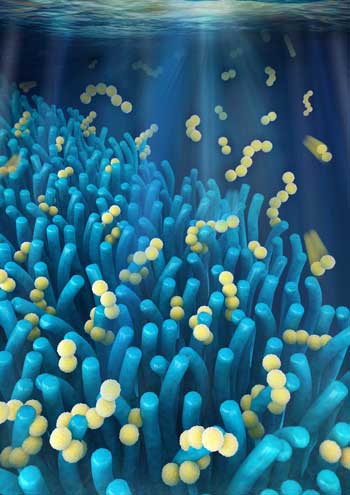| Posted: Oct 26, 2016 |
Next-generation smartphone battery inspired by the gut
(Nanowerk News) A new prototype of a lithium-sulphur battery – which could have five times the energy density of a typical lithium-ion battery – overcomes one of the key hurdles preventing their commercial development by mimicking the structure of the cells which allow us to absorb nutrients.
|
|
Researchers have developed a prototype of a next-generation lithium-sulphur battery which takes its inspiration in part from the cells lining the human intestine. The batteries, if commercially developed, would have five times the energy density of the lithium-ion batteries used in smartphones and other electronics.
|
 |
| Computer visualisation of villi-like battery material. (Image: Teng Zhao)
|
|
The new design, by researchers from the University of Cambridge, overcomes one of the key technical problems hindering the commercial development of lithium-sulphur batteries, by preventing the degradation of the battery caused by the loss of material within it. The results are reported in the journal Advanced Functional Materials ("Advanced Lithium-Sulfur Batteries Enabled by a Bio-Inspired Polysulfide Adsorptive Brush").
|
|
Working with collaborators at the Beijing Institute of Technology, the Cambridge researchers based in Dr Vasant Kumar’s team in the Department of Materials Science and Metallurgy developed and tested a lightweight nanostructured material which resembles villi, the finger-like protrusions which line the small intestine. In the human body, villi are used to absorb the products of digestion and increase the surface area over which this process can take place.
|
|
In the new lithium-sulphur battery, a layer of material with a villi-like structure, made from tiny zinc oxide wires, is placed on the surface of one of the battery’s electrodes. This can trap fragments of the active material when they break off, keeping them electrochemically accessible and allowing the material to be reused.
|
|
“It’s a tiny thing, this layer, but it’s important,” said study co-author Dr Paul Coxon from Cambridge’s Department of Materials Science and Metallurgy. “This gets us a long way through the bottleneck which is preventing the development of better batteries.”
|
|
A typical lithium-ion battery is made of three separate components: an anode (negative electrode), a cathode (positive electrode) and an electrolyte in the middle. The most common materials for the anode and cathode are graphite and lithium cobalt oxide respectively, which both have layered structures. Positively-charged lithium ions move back and forth from the cathode, through the electrolyte and into the anode.
|
|
The crystal structure of the electrode materials determines how much energy can be squeezed into the battery. For example, due to the atomic structure of carbon, each carbon atom can take on six lithium ions, limiting the maximum capacity of the battery.
|
|
Sulphur and lithium react differently, via a multi-electron transfer mechanism meaning that elemental sulphur can offer a much higher theoretical capacity, resulting in a lithium-sulphur battery with much higher energy density. However, when the battery discharges, the lithium and sulphur interact and the ring-like sulphur molecules transform into chain-like structures, known as a poly-sulphides. As the battery undergoes several charge-discharge cycles, bits of the poly-sulphide can go into the electrolyte, so that over time the battery gradually loses active material.
|
|
The Cambridge researchers have created a functional layer which lies on top of the cathode and fixes the active material to a conductive framework so the active material can be reused. The layer is made up of tiny, one-dimensional zinc oxide nanowires grown on a scaffold. The concept was trialled using commercially-available nickel foam for support. After successful results, the foam was replaced by a lightweight carbon fibre mat to reduce the battery’s overall weight.
|
|
“Changing from stiff nickel foam to flexible carbon fibre mat makes the layer mimic the way small intestine works even further,” said study co-author Dr Yingjun Liu.
|
|
This functional layer, like the intestinal villi it resembles, has a very high surface area. The material has a very strong chemical bond with the poly-sulphides, allowing the active material to be used for longer, greatly increasing the lifespan of the battery.
|
|
“This is the first time a chemically functional layer with a well-organised nano-architecture has been proposed to trap and reuse the dissolved active materials during battery charging and discharging,” said the study’s lead author Teng Zhao, a PhD student from the Department of Materials Science & Metallurgy. “By taking our inspiration from the natural world, we were able to come up with a solution that we hope will accelerate the development of next-generation batteries.”
|
|
For the time being, the device is a proof of principle, so commercially-available lithium-sulphur batteries are still some years away. Additionally, while the number of times the battery can be charged and discharged has been improved, it is still not able to go through as many charge cycles as a lithium-ion battery. However, since a lithium-sulphur battery does not need to be charged as often as a lithium-ion battery, it may be the case that the increase in energy density cancels out the lower total number of charge-discharge cycles.
|
|
“This is a way of getting around one of those awkward little problems that affects all of us,” said Coxon. “We’re all tied in to our electronic devices – ultimately, we’re just trying to make those devices work better, hopefully making our lives a little bit nicer.”
|

